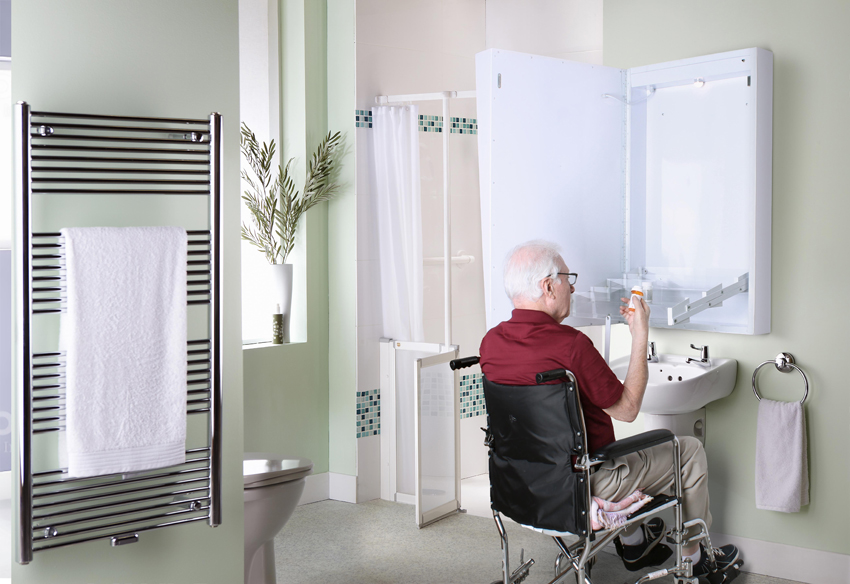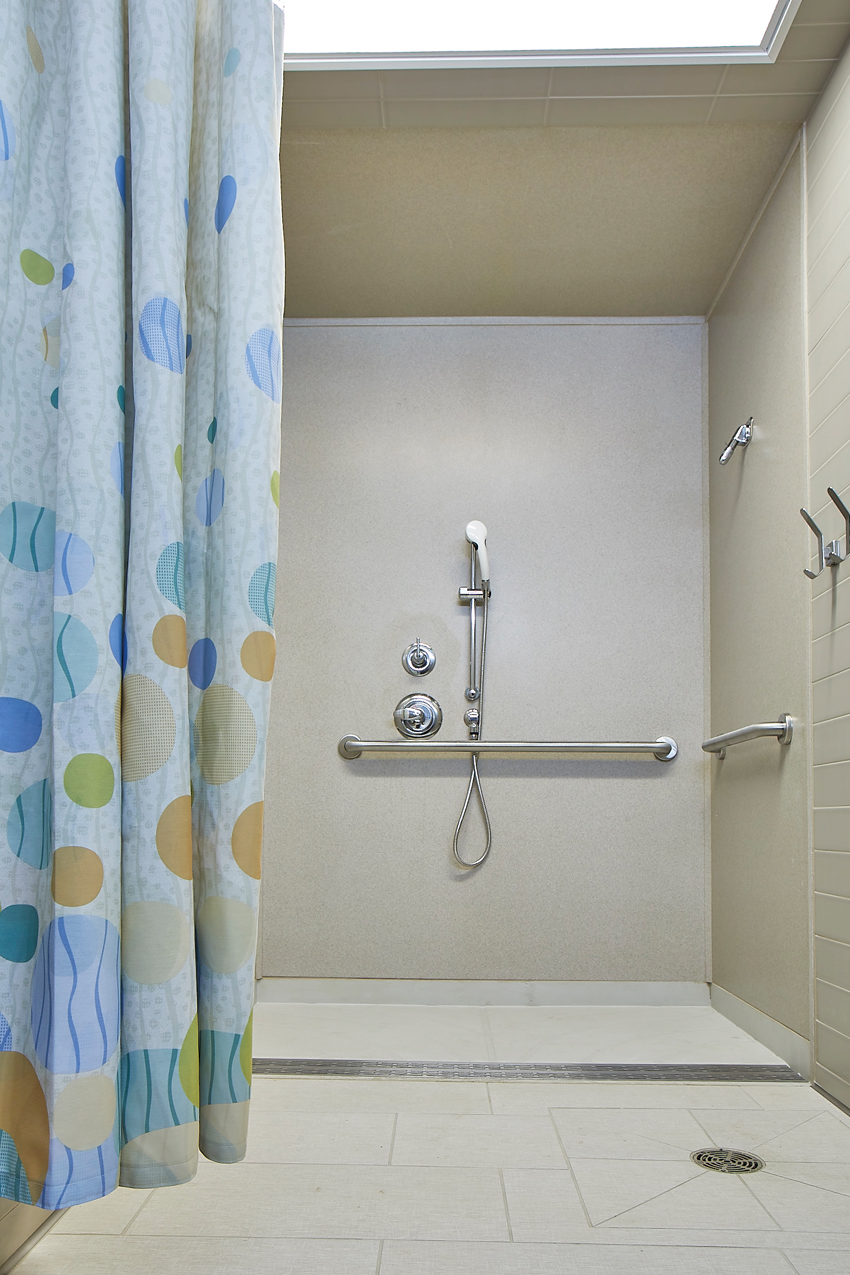Health-Care Design for All
Identifying Standards
ICC ANSI 117.1 addresses sinks and wheelchair accessibility. It also addresses high and low reaching heights from a wheelchair and differentiates between unobstructed and obstructed reaching conditions. A medicine cabinet over a sink creates an obstructed situation. The 117.1 standard defines that obstruction since it defines the parameters for the sink in Section 606: Lavatories and Sinks. First, the required clear space in front of the sink is defined based on Section 305 and a forward approach, meaning that the person in a wheelchair is able to reach forward to access the sink. The sink itself is required to be no higher than 34 inches from the floor. An enhanced reach range is acknowledged if the sink is no more than 11 inches deep. If a more standard condition occurs where the sink is in a countertop that is approximately 17 to 24 inches deep, the reach range is not considered to be enhanced.
In terms of reaching something above the sink, Section 308: Reach Ranges is the applicable part of the 117.1 standard. Section 308.2.2 related to Obstructed High Reach points out that “the clear floor space complying with Section 305 shall extend beneath the element…” thus allowing full access by pulling forward to reach the wall above the sink. It goes on to indicate that there are two different high forward-reach height limits: a 48-inch maximum above the floor applies where the reach depth is 20 inches or less, while 44 inches is the maximum reach height if the depth exceeds 20 inches but up to a maximum of 25 inches.
In the case of providing an accessible medicine cabinet over a sink, the standard dictates that the bottom of that cabinet (and the access to anything in it) must fall between 34 inches above the floor (maximum sink height) and either 44 or 48 inches above the floor depending on the depth of the sink/counter. Where a mirror is on the face of the medicine cabinet, the bottom of the mirror is dictated in the 117.1 Standard in Section 603.3: Mirrors. In this case, it requires it to “be mounted with the bottom edge of the reflecting surface 40 inches maximum above the floor.” This simply places the mirrored surface a bit closer to the sink height but does not change the maximum reaching height inside the medicine cabinet.
Providing Solutions
The accessible range of someone in a wheelchair is limited to approximately 10 to 14 inches of height above a sink—or less. That severely limits access to medications or other needed health products. Keeping in mind that every individual’s needs are different, solutions that emphasize flexibility and maximize accessibility usually serve the greatest number of people.
An excellent example of such innovation is found in a medicine cabinet now on the market that combines accessibility and ingenuity. This cabinet allows someone in a wheelchair to reach the bottom of the cabinet door above the sink and open it to reveal the contents inside. While normally someone would only be able to reach the bottom shelf of the cabinet, this design includes a vertically hanging handle that is connected to a cleverly designed shelf system that the user can pull easily downward. Individual shelves adjust with gravity as they are lowered, allowing all of the contents to remain on the shelf and be placed directly above the sink in front of the person. Hence, all of the contents of the cabinet are now accessible to the user. When done, the shelves are simply pushed back up into place and the door closed. This synchronized operation allows the user to act completely independently from the wheelchair without requiring assistance or standing.
In addition to this helpful functionality, the cabinet features a residential style and intentionally simple aesthetic. The medicine chest provides a clean-looking mirrored cabinet that is angled downward on the front so that wheelchair users can see themselves easily. The cabinet is also illuminated both on the outside and inside, providing light above the sink and easy visibility of the contents inside the chest.
Liz Congero, vice president of sales and marketing for Aamsco Lighting, notes the positive impact of this type of innovation, saying, “The overall net effect is that elderly or physically challenged people can remain in their homes or a long-term care facility and maintain a level of independence. This helps with a person’s well-being, which can also be linked to addressing concerns about having access to their medications without assistance.” This innovative solution combines accessibility and architectural design, providing a model for the types of features we should expect in today’s health-care facilities.

Photo courtesy of AAMSCO Lighting
This illuminated and mirrored medicine chest allows a wheelchair user to independently access medications and toiletries.
Solid-Surface Shower Surrounds and Pans
Showers in health-care facilities must be easy to clean, sanitary, and safe for the patients and residents who use them. Solid surface, typically made from a combination of acrylic and polyester resins, is an excellent material choice for shower surrounds and shower pans in health-care environments. Because the material is non-nutritive, it does not promote the growth of mold and mildew and resists bacterial growth. In addition, the inclusion of “active” antimicrobials within the solid surface can reduce odor-causing bacteria.
Solid surface has a huge advantage over tile, as it does not include grout, which is a favorite substrate for mold and bacteria. The material is also much easier to clean than grouted tile.
Designs can be routed into the solid surface to mimic the look of tile without compromising the material’s integrity. Designers can select smooth panels or, for a more residential aesthetic, choose from an array of decorative designs such as diamonds, subway tile, basic squares, and beadboard.
Receptors or pans made from solid surface can be poured into squares and rectangles of varying sizes. The integral non-skid surface helps prevent slips and falls, and ADA edges and ramps can ease the transition from floor to receptor. Drain locations can be set to match existing plumbing; trench drains are also an option.
Shower bases can be poured and fabricated into an almost unlimited array of custom shapes. In addition, factory-fabricated shower receptors ensure consistent quality and material performance through rigorous production standards.
Solid-surface products boast a long life cycle, reducing maintenance and replacement costs. The material is extremely durable and will not degrade. Most importantly, it looks new for a very long time.
Fabric Shower Curtains
Designers have several options when it comes to enclosing a shower. While new designs are incorporating doorless showers or glass doors, many facilities still have shower curtains for privacy. The right choice of curtain material can be enlisted to help keep mold and mildew in check.

Photo courtesy of Inpro
Solid-surface shower surrounds and antimicrobial curtains help maintain a cleaner environment, which boosts overall patient comfort and satisfaction.
Bio-static shower curtains resist mold and bacteria and are made from durable, multipurpose vinyl for easy cleaning and low maintenance. These curtains are also available in a variety of colors and styles and can contribute to the room’s aesthetic. ADA models feature a bottom lip and side Velcro seals to keep water in the shower area, which reduces the risk of slips and falls.
FLEXIBLE AND HYGIENIC INTERIORS
More than ever, health-care facilities must be able to accommodate fluctuating caseloads. At times, rooms may need to be partitioned to make the best use of space. Fortunately, there are solutions for changing the configuration of rooms that are not only hygienic and safe but also offer a pleasing aesthetic.
When partitioning a space, there are several factors to consider. The HVAC system has likely been designed to maintain airflow and ensure airborne pathogens do not accumulate. It is important that a partition does not block this important function. In some cases, it may also be important that the partition does not block access to light. Finally, it should not obscure wayfinding signage.
Although functionality and cleanliness are critical in health-care facilities, aesthetics play an important role in creating an appealing environment that promotes healing. Increasingly, these facilities are incorporating design elements that feel warm and welcoming rather than cold and sterile. Many of these elements also bring a touch of nature into the facility—a strategy which has been shown to promote well-being and healing and even reduce the length of hospital stays. This can be accomplished through a combination of elements, including finishes and flooring, partitions, curtains, wallcoverings, and lighting. Artificial lighting and daylighting in particular play a key role in illuminating a space and creating an appealing indoor environment in which to live, work, and heal.
Notice

www.aamsco.com/mirrors/wheelchair-medicine-chest

www.cascade-architectural.com

www.inprocorp.com









